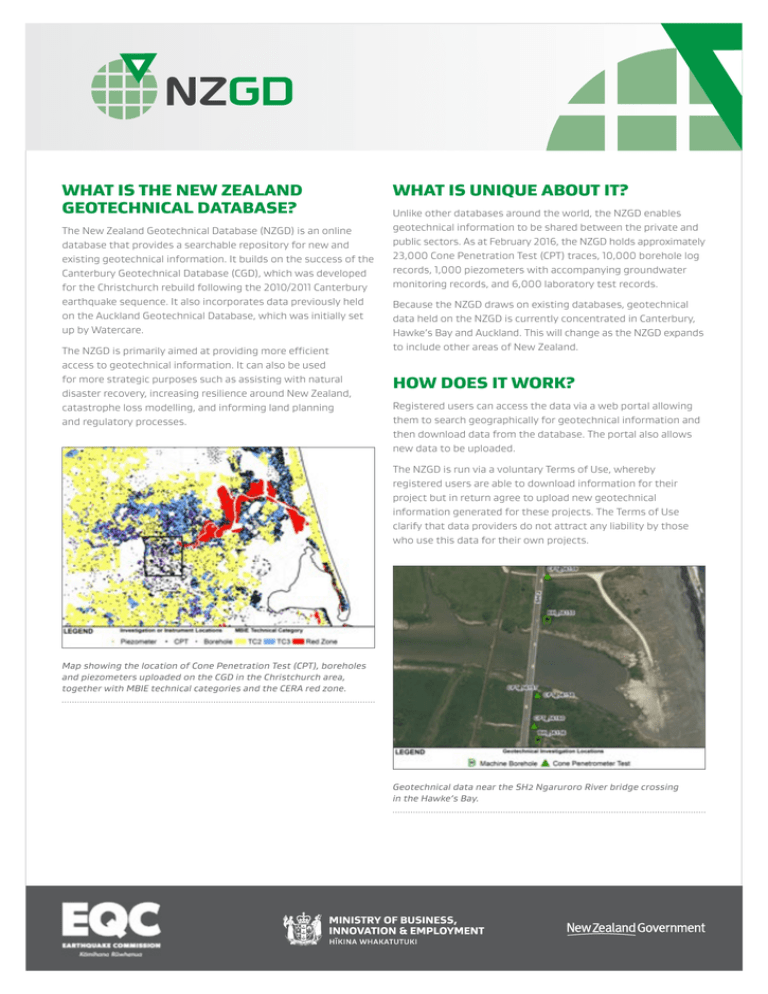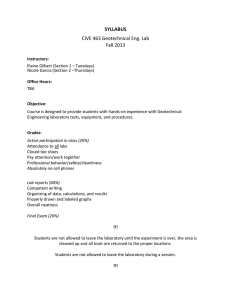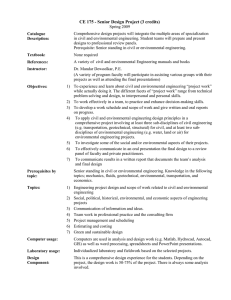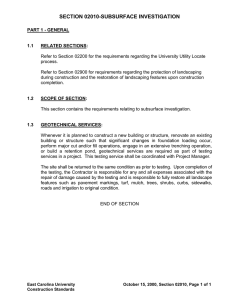WHAT IS THE NEW ZEALAND GEOTECHNICAL DATABASE
advertisement

WHAT IS THE NEW ZEALAND GEOTECHNICAL DATABASE? The New Zealand Geotechnical Database (NZGD) is an online database that provides a searchable repository for new and existing geotechnical information. It builds on the success of the Canterbury Geotechnical Database (CGD), which was developed for the Christchurch rebuild following the 2010/2011 Canterbury earthquake sequence. It also incorporates data previously held on the Auckland Geotechnical Database, which was initially set up by Watercare. The NZGD is primarily aimed at providing more efficient access to geotechnical information. It can also be used for more strategic purposes such as assisting with natural disaster recovery, increasing resilience around New Zealand, catastrophe loss modelling, and informing land planning and regulatory processes. WHAT IS UNIQUE ABOUT IT? Unlike other databases around the world, the NZGD enables geotechnical information to be shared between the private and public sectors. As at February 2016, the NZGD holds approximately 23,000 Cone Penetration Test (CPT) traces, 10,000 borehole log records, 1,000 piezometers with accompanying groundwater monitoring records, and 6,000 laboratory test records. Because the NZGD draws on existing databases, geotechnical data held on the NZGD is currently concentrated in Canterbury, Hawke’s Bay and Auckland. This will change as the NZGD expands to include other areas of New Zealand. HOW DOES IT WORK? Registered users can access the data via a web portal allowing them to search geographically for geotechnical information and then download data from the database. The portal also allows new data to be uploaded. The NZGD is run via a voluntary Terms of Use, whereby registered users are able to download information for their project but in return agree to upload new geotechnical information generated for these projects. The Terms of Use clarify that data providers do not attract any liability by those who use this data for their own projects. Map showing the location of Cone Penetration Test (CPT), boreholes and piezometers uploaded on the CGD in the Christchurch area, together with MBIE technical categories and the CERA red zone. Geotechnical data near the SH2 Ngaruroro River bridge crossing in the Hawke’s Bay. WHAT ARE THE BENEFITS? In addition to data sharing, an extensive geotechnical dataset provides the following benefits: ›› There is reduced cost in holding and retrieving geotechnical information (particularly your own) that is commonly held off-site by advisors on your behalf ›› Advisors can more easily access geotechnical information provided by others, saving on your own investigation costs ›› High-level assessments can be carried out for specific projects using information from the surrounding area to better inform the geotechnical profile prior to committing to more detailed studies ›› Seismic ground performance data in Christchurch can be accessed for use as a benchmark for expected ground performance in similar geological settings, particularly areas with complex subsurface geological models I AM INTERESTED IN BOTH DOWNLOADING AND CONTRIBUTING DATA – HOW DO I GET STARTED? If you are a technical professional, you are encouraged to register as a user. Once your registration is approved, you can start downloading data immediately. Under the Terms of Use those downloading data are also obliged to upload new data as it becomes available. This will require you to seek permission from your client, who would normally own the data. In most cases, it makes sense for the client to give permission as this will save them in investigation costs both now and in the future. Ground Ground Ground Investigation Investigation Investigation Ltd LtdLtd PO Box PO PO Box 180Box 180 165, 180 165, Lukens 165, Lukens Lukens PointPoint Point Permission is most easily obtained at the point of commission WestWest Harbour, West Harbour, Harbour, Auckland. Auckland. Auckland. 06630663 NZ 0663 NZ NZ www.g-i.co.nz www.g-i.co.nz www.g-i.co.nzmarco@g-i.co.nz marco@g-i.co.nz marco@g-i.co.nz by the geotechnical specialist. Project: Project: Project: Papakura Papakura Papakura Stormwater Stormwater Stormwater Upgrade Upgrade Upgrade CPT:CPT: CPT-05 CPT: CPT-05 CPT-05 - Total - Total -depth: Total depth: depth: 19.93 19.93 (m) 19.93 (m)(m) ›› Infrastructure providers can be more informed in their asset management (such as operational and capital expenditure budgeting), can better target more vulnerable areas for strengthening, and, following an event, optimise the repair/ replacement effort ›› Sub-surface data can be provided to regulatory authorities and decision makers to enable them to make well-informed land planning decisions and determine the appropriateness of investment strategies and solutions ›› Regulatory guidance can be prepared to assess the likely impact of new or changes to existing design guidelines and building codes ›› Specialist contractors can assess opportunities for investing in specialist equipment and ground improvement construction techniques ›› Quantity surveyors and estimators can be assisted in estimating appropriate foundation rebuild costs so property owners can specify appropriate sum insured values for their insurance policies ›› Improved catastrophe loss modelling for insurance and hazard management is enabled, while emergency response specialists are able to carry out appropriate scenario response activities. Access to extensive geotechnical datasets also allows the research community to undertake research projects that normally would not be possible due to budget constraints. WHO IS THE DATABASE FOR? MB13379_APR16 The database is designed as a tool for technical professionals to share and use geotechnical data. The information held on the database is mostly a collection of raw data comprising scientific and engineering properties of the ground conditions rather than an interpretation of the data. The data is normally gathered, interpreted and conveyed to the client by a geotechnical engineer. The The plotThe plot below plot below presents below presents presents the cross thethe cross correlation cross correlation correlation coeficient coeficient coeficient between between between the raw thethe raw qc raw and qc and qc fs values and fs values fs (as values measured (as (as measured measured on the on field). on thethe field). Xfield). axes X axes X presents axes presents presents the lag thethe lag lag distance distance distance (one(one lag(one islagthe lag is distance the is the distance distance between between between two two sucessive two sucessive sucessive CPT CPT measurements). CPT measurements). measurements). Example of cone penetration test data (CPT) downloaded from NZGD. WHAT DOES IT COST? The NZGD is free for registered users. The user’s commitment to upload new data as it becomes available is outlined in the Terms of Use. HOW IS IT FUNDED? The database is funded by the Ministry of Business, Innovation and Employment’s building levy and by the Earthquake Commission. CPeT-IT CPeT-IT CPeT-IT v.1.6.5.31 v.1.6.5.31 v.1.6.5.31 - CPTU - CPTU -data CPTU data presentation data presentation presentation & interpretation & interpretation & interpretation software software software - Report - Report - Report created created created on: 14/12/2011, on:on: 14/12/2011, 14/12/2011, 4:27:49 4:27:49 4:27:49 p.m.p.m. p.m. Project Project file: Project S:\Geotechnical file:file: S:\Geotechnical S:\Geotechnical Consultants\GB-2010\GB001-GB100\GB020\Appendix Consultants\GB-2010\GB001-GB100\GB020\Appendix Consultants\GB-2010\GB001-GB100\GB020\Appendix C - CPT\Papakura C - CPT\Papakura C - CPT\Papakura Pipeline.cpt Pipeline.cpt Pipeline.cpt 29 29 29



